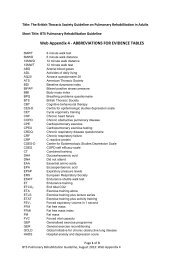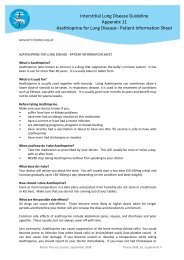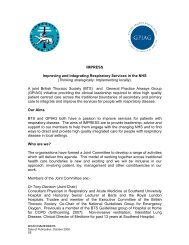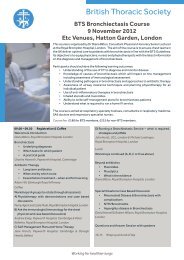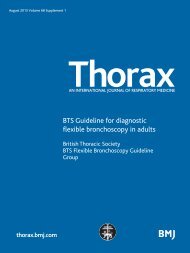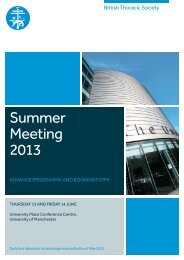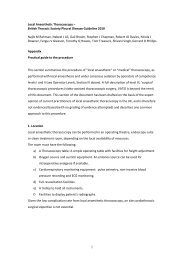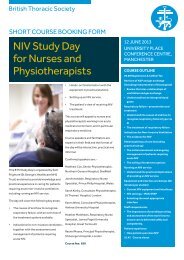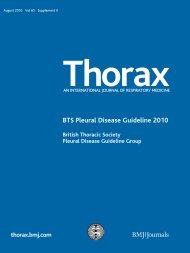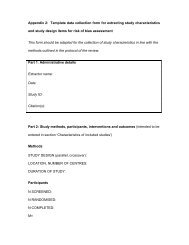Guidelines for the management of community ... - Brit Thoracic
Guidelines for the management of community ... - Brit Thoracic
Guidelines for the management of community ... - Brit Thoracic
You also want an ePaper? Increase the reach of your titles
YUMPU automatically turns print PDFs into web optimized ePapers that Google loves.
BTS guidelines<br />
pneumococcal DNA target(s) sought. However, relatively few<br />
studies report comprehensive clinical—as opposed to analytical<br />
sensitivity—evaluations <strong>of</strong> pneumococcal PCRs in <strong>the</strong> diagnosis<br />
<strong>of</strong> CAP. One retrospective study 225 [III] compared three different<br />
PCR methodologies <strong>for</strong> use on EDTA blood samples from 175<br />
bacteraemic patients collected at hospital admission (95<br />
pneumococcal bacteraemia and 80 with bacteraemia due to<br />
o<strong>the</strong>r organisms). The best sensitivity obtained was 45% versus<br />
<strong>the</strong> gold standard <strong>of</strong> a positive blood culture <strong>for</strong> S pneumoniae.<br />
The specificity <strong>of</strong> all three methods was good at 97–100%. The<br />
authors concluded that blood PCR <strong>of</strong>fers no advantage over<br />
conventional blood culture <strong>for</strong> pneumococcal diagnosis in<br />
bacteraemic patients and is unlikely to be sufficiently sensitive<br />
<strong>for</strong> diagnosis <strong>of</strong> non-bacteraemic pneumococcal pneumonia.<br />
Pneumococcal PCR has also been applied to sputum and o<strong>the</strong>r<br />
respiratory tract samples. However, obtaining a good quality<br />
sputum sample, as described above, remains problematic and,<br />
more importantly, PCR is not readily able to distinguish<br />
colonisation from infection <strong>of</strong> <strong>the</strong> respiratory tract. 226 [III]<br />
Pneumococcal PCR has little to <strong>of</strong>fer <strong>for</strong> <strong>the</strong> diagnosis <strong>of</strong> CAP<br />
at this time, being insufficiently sensitive and specific <strong>for</strong><br />
routine use.<br />
Recommendations<br />
c Pneumococcal urine antigen tests should be per<strong>for</strong>med<br />
<strong>for</strong> all patients with moderate or high severity CAP.<br />
[A2]<br />
c A rapid testing and reporting service <strong>for</strong> pneumococcal<br />
urine antigen should be available to all hospitals<br />
admitting patients with CAP. [B+]<br />
5.11.5 Tests <strong>for</strong> Legionnaires’ disease<br />
Legionella pneumonia can be severe and carries a significant<br />
mortality. Prompt diagnosis is important both <strong>for</strong> patient<br />
<strong>management</strong> and <strong>for</strong> public health investigations. Risk factors<br />
<strong>for</strong> legionella infection include recent travel (within 10 days <strong>of</strong><br />
onset), certain occupations, recent repair to domestic plumbing<br />
systems and immunosuppression.<br />
Urine antigen detection<br />
Detection <strong>of</strong> L pneumophila urinary antigen by enzyme<br />
immunoassay (EIA) is established as a highly specific (.95%)<br />
and sensitive (,80%) test 227 [III] <strong>for</strong> <strong>the</strong> detection <strong>of</strong> infections<br />
caused by L pneumophila serogroup 1, <strong>the</strong> commonest cause <strong>of</strong><br />
sporadic and travel CAP cases in <strong>the</strong> UK. Rapid results can be<br />
obtained at an early stage <strong>of</strong> <strong>the</strong> illness, and this is a valuable<br />
method in <strong>the</strong> early diagnosis <strong>of</strong> legionella infection. 92 [III] It is<br />
now widely applied in high severity CAP. A recent survey <strong>of</strong><br />
215 [III]<br />
diagnostic microbiology laboratories in England and Wales<br />
revealed that, <strong>of</strong> 138 respondents, 136 laboratories (99%) <strong>of</strong>fered<br />
this test <strong>for</strong> patients with CAP.<br />
One study looked at <strong>the</strong> value <strong>of</strong> rapid legionella urine<br />
antigen testing in a large outbreak <strong>of</strong> Legionnaires’ disease<br />
caused by L pneumophila serogroup 1 in Holland. 228 [III] This<br />
showed a higher test positivity rate <strong>for</strong> patients with severe<br />
legionella infection. The authors also demonstrated that <strong>the</strong><br />
results <strong>of</strong> rapid testing could be used to start early legionella<br />
appropriate antibiotic <strong>management</strong> resulting in an improved<br />
outcome, as shown by reducing both mortality and <strong>the</strong> need <strong>for</strong><br />
intensive care. In ano<strong>the</strong>r prospective study <strong>of</strong> sporadic CAP in<br />
adults, <strong>the</strong> early detection <strong>of</strong> urine legionella antigen positively<br />
There<br />
influenced <strong>the</strong> <strong>management</strong> <strong>of</strong> seven <strong>of</strong> nine patients in whom<br />
37 [Ib]<br />
it was detected.<br />
Thorax 2009;64(Suppl III):iii1–iii55. doi:10.1136/thx.2009.121434<br />
are several commercial assays available, including a<br />
rapid immunochromatographic test. These assays principally<br />
detect infection with L pneumophila serogroup 1. They do not<br />
reliably detect antigen from o<strong>the</strong>r serogroups or legionella<br />
species which can cause infection in immunocompromised<br />
patients who may present with CAP, or recently hospitalised<br />
patients. This has particular significance in nosocomial infection.<br />
In one study <strong>of</strong> culture confirmed cases, while <strong>the</strong><br />
sensitivity <strong>of</strong> commercially available urine antigen tests was<br />
93.7% <strong>for</strong> travel-associated cases and 86.5% <strong>for</strong> <strong>community</strong>acquired<br />
cases, it was only 45% <strong>for</strong> nosocomial<br />
229 [III]<br />
cases.<br />
Legionella direct immun<strong>of</strong>luorescence tests<br />
L pneumophila can be detected by direct immun<strong>of</strong>luorescence<br />
(DIF) on invasive respiratory samples such as bronchial<br />
aspirates. L pneumophila specific reagents should be used, and<br />
not hyperimmune rabbit antisera which are poorly specific. The<br />
value <strong>of</strong> per<strong>for</strong>ming DIF on expectorated sputum samples is less<br />
well established. A considerable degree <strong>of</strong> laboratory expertise is<br />
required <strong>for</strong> processing and interpretation and, in view <strong>of</strong> <strong>the</strong><br />
widespread availability <strong>of</strong> urine antigen tests <strong>for</strong> legionella<br />
diagnosis, <strong>the</strong> use <strong>of</strong> DIF has declined in recent years in <strong>the</strong> UK.<br />
Culture<br />
The culture <strong>of</strong> legionella from clinical samples (principally<br />
respiratory samples, including sputum) is very important and<br />
every ef<strong>for</strong>t should be made to diagnose by this method. Culture<br />
is 100% specific and is <strong>the</strong> only reliable method <strong>of</strong> detecting<br />
infection with non-pneumophila legionella species. Culture is<br />
also valuable <strong>for</strong> epidemiological investigations, allowing<br />
phenotypic and genotypic comparison <strong>of</strong> clinical and environmental<br />
legionella strains.<br />
Problems with culture include: <strong>the</strong> inability <strong>of</strong> many patients<br />
with legionella pneumonia to produce sputum samples; prior<br />
antibiotic <strong>the</strong>rapy; laboratory time and cost in processing<br />
samples; and lack <strong>of</strong> rapid results (legionella cultures need to<br />
be incubated <strong>for</strong> up to 10 days). Few laboratories will set up<br />
legionella cultures on respiratory samples unless specifically<br />
requested to do so. Culture should always be attempted from<br />
urine antigen positive patients and in suspected nosocomial<br />
legionella infection.<br />
Serology<br />
The diagnosis by determination <strong>of</strong> antibody levels was <strong>the</strong><br />
mainstay <strong>of</strong> diagnosis <strong>of</strong> legionella pneumonia in <strong>the</strong> past.<br />
Serological assays previously employed in <strong>the</strong> UK were highly<br />
specific, although false positive results due to a serological crossreaction<br />
may occur in patients with recent Campylobacter<br />
infection. 230 [II] Serological reagents <strong>for</strong> legionella diagnosis are<br />
no longer available from <strong>the</strong> Health Protection Agency. Their<br />
place has been filled by a number <strong>of</strong> commercially available<br />
serological assays <strong>of</strong> varying sensitivity and specificity. It is<br />
currently recommended that, where a diagnosis <strong>of</strong> legionella<br />
infection relies solely on <strong>the</strong> results <strong>of</strong> serological testing, <strong>the</strong><br />
sample should be referred to a reference laboratory <strong>for</strong><br />
confirmation.<br />
PCR<br />
Detection <strong>of</strong> legionella DNA by PCR from respiratory samples is<br />
still only available as a reference laboratory or research tool,<br />
although it is becoming more widely available.<br />
iii23



